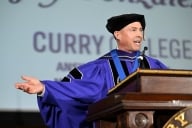You have /5 articles left.
Sign up for a free account or log in.
SAN FRANCISCO—As the presidents of hundreds of small private institutions listened to leaders from Bay Area technology companies discuss the future of the workforce here at an annual gathering of the Council of Independent Colleges last week, their questions to the speakers revealed their yearning for affirmation of the continued value of the liberal arts and sciences.
“I’m not hearing this morning about a migration away from the liberal arts, or the death of the liberal arts,” Daniel Lugo, president of Queens University of Charlotte and the session’s moderator, said to the three female executives on the stage with him. “It sounds like you’re saying it’s really about better articulating and rebranding, about how we market what we’re doing.”
That’s certainly part of the equation, said Van Ton-Quinlivan, CEO of Futuro Health, a nonprofit group that works with colleges and companies to prepare workers for jobs in health care. “It’s important that we make overt what students are already learning,” she said, by helping them understand what learning outcomes they’re achieving in their courses so they can translate them to prospective employers.
But in an era when employers are basing their hiring decisions more on the skills and knowledge would-be workers have than on the degrees they’ve attained, college graduates are increasingly competing against candidates who’ve developed those abilities in other ways, said Katie Ferrick, senior director of workplace programs at LinkedIn.
“If we’re hiring based on skills, that’s going to open up much more opportunity for a more equitable and diverse workplace. That doesn’t mean that there’s less value to a degree, but there are more avenues to those who earn those skills other ways, too.”
In that more competitive landscape, Ferrick and others said, colleges should think in terms of “both-and”—delivering a four-year degree grounded in the liberal arts that remains the best preparation for a lifetime career, yes, but also building into their curricula more practical digital and other skills that can help graduates compete for a first job.
“Your institutions can help that student develop, discover, find their purpose and passion, while they’re picking up all kinds of skills along the way,” Ferrick said.
Ton-Quinlivan, for instance, said it was incumbent on colleges to ensure that graduates seeking to enter health care fields are able to “function and collaborate in a virtual environment,” given the growth of (and continued dependence on) telehealth. “If two candidates with the same [degree] are going for a job, if one can show she can operate in a virtual environment, they’ll get the job.”
How would a student getting a traditional residential education signal that capacity? she asked. Ton-Quinlivan then answered her own question: “Maybe digital badging. Something that shows they’ve had extra time, extra expertise in that … It’s important that you experiment with these practices within your own environment in ways that make sense for you.”
The conversation was a highlighted session at the Council of Independent Colleges’ Presidents Institute, and it represented a deepening worry among officials at colleges and universities (especially those with a liberal arts orientation) about public and employer questioning of the value of degrees in humanities and social science disciplines. Any discussion of a crisis in the liberal arts needs to be asterisked with the reality that people have been using such rhetoric for decades—here’s a link to a 1971 article in Change magazine entitled “The Impending Crisis of the Liberal Arts Colleges.”
But there is plenty to worry about, with enrollments already flattening ahead of an expected demographic decline, constrained financial resources and those pesky public doubts. And while the presidents gathered here projected confidence in most public conversations, they flocked to sessions with titles such “Financially Sustainable Strategies for Smaller Colleges” and shared more pessimistic takes in one-on-one conversations with peers (and off-the-record discussions with journalists).
They were not shy about expressing their concerns about what students (and parents) are hearing about the value of going to college, and especially to institutions like theirs.
“I live in a part of the country where people are being discouraged from going to seek a college degree, or told to go to other types of skill-based schools,” Pamela Gunter-Smith, president of York College of Pennsylvania, said in introducing a question about alternative credentials to the panelists in the workforce conversation. (York’s county was won handily by Donald Trump in the 2020 presidential race and Dr. Mehmet Oz in the state’s 2022 Senate race.)
In response to the mention of “skills-based hiring” during the workforce session, another audience member asked nervously if the applicant tracking systems the companies use in hiring would “screen out people early” in the process who lack clear evidence of having technical and other “hard” skills desired for certain positions.
In general, the corporate leaders sought to reassure the presidents that their companies still value graduates with the sorts of communication, critical thinking and other “soft” skills (or “people” or “power” skills—take your pick) that these institutions still emphasize.
Cinthia Lopez, director of talent outreach for Google, said that as the many technology companies like hers “grow up,” their need for many nontechnical roles in fields such as project management, marketing and human resources expands, creating many opportunities for workers with problem-solving skills, leadership traits and “endless curiosity.”
Ton-Quinlivan noted that as Futuro Health has developed its curriculum to prepare people to work in health care information technology, learners take a set of courses designed to develop six core interpersonal skills before they take any technical courses.
Lopez also reassured the college leaders that Google still hires many more employees with two- and four-year degrees than the “hundreds” it will hire who have a certificate or industry certification alone.
“There will continue to be a ton of appetite for the college degree,” she said. “I’m still a big believer.”
But much work remains to be done to infuse more practical experience and skill development into the general education and liberal arts curriculum (should any student graduate college today unable to create a pivot table in Microsoft Excel? To produce a data visualization in Tableau?).
“How do you embed some of these skill sets, these industry-recognized credentials, into your curricular experience?” Ton-Quinlivan said. (She acknowledged this might require some retraining of faculty members, too.)
And liberal arts colleges would be wise, the corporate leaders said, to incorporate into course descriptions, assessments and transcripts the skills that academic experiences are developing in students—those dreaded “learning outcomes.”
“We should ask, ‘What skills did they learn from it? Spell it out in more skill-based words,’” said Ferrick of LinkedIn. That can give learners themselves language they can use to sell themselves to employers, she said, and put those learners on the radar screens of hiring managers who use keywords to sort through applicants.
“This isn’t about creating some new program at your college but on helping students and faculty figure out how to connect the dots between what they’re learning and what skills they’re gaining, Ferrick said.
Colleges that don’t move in this direction may see continued enrollment declines, said Ton-Quinlivan, who attributed at least some of the recent attrition to students’ dissatisfaction with a perceived lack of practicality in their postsecondary educations. “They’re asking for the ‘and.’”









